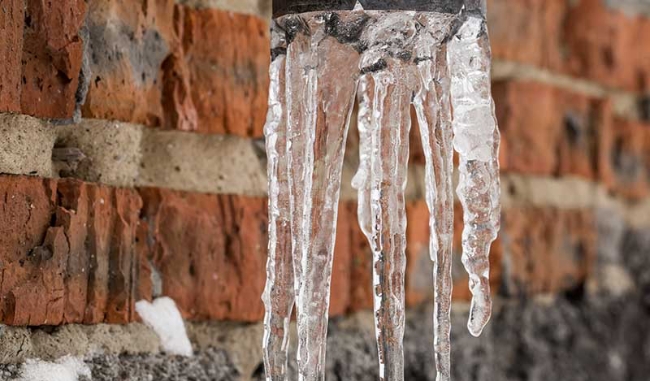Tips to Avoid Frozen Pipes in Cold Weather: Expert Guidance
Tips to Avoid Frozen Pipes in Cold Weather: Expert Guidance
Blog Article
This great article on the next paragraphs relating to Helpful Tips to Prevent Frozen Pipes this Winter is fairly enlightening. You should give it a look.

Cold weather can wreak havoc on your plumbing, particularly by freezing pipes. Here's exactly how to stop it from taking place and what to do if it does.
Introduction
As temperature levels decline, the threat of icy pipelines boosts, potentially bring about expensive fixings and water damage. Understanding how to prevent icy pipelines is essential for homeowners in cold climates.
Prevention Tips
Protecting prone pipelines
Wrap pipelines in insulation sleeves or utilize heat tape to protect them from freezing temperature levels. Focus on pipelines in unheated or outside areas of the home.
Home heating techniques
Maintain interior rooms sufficiently heated, particularly areas with plumbing. Open up cabinet doors to permit warm air to distribute around pipelines under sinks.
How to determine icy pipes
Search for lowered water flow from faucets, unusual smells or sounds from pipes, and visible frost on subjected pipelines.
Long-Term Solutions
Architectural changes
Consider rerouting pipes away from exterior walls or unheated locations. Add added insulation to attics, cellars, and crawl spaces.
Upgrading insulation
Buy top notch insulation for pipes, attic rooms, and wall surfaces. Appropriate insulation aids maintain regular temperatures and minimizes the threat of frozen pipes.
Shielding Outdoor Plumbing
Yard hoses and outside taps
Separate and drain garden hose pipes prior to winter months. Install frost-proof spigots or cover outside taps with shielded caps.
Understanding Icy Pipes
What triggers pipes to ice up?
Pipelines freeze when revealed to temperature levels below 32 ° F (0 ° C) for extended periods. As water inside the pipes ices up, it increases, putting pressure on the pipeline wall surfaces and potentially causing them to break.
Risks and problems
Icy pipelines can cause water disruptions, residential or commercial property damages, and pricey repairs. Burst pipes can flooding homes and cause extensive structural damage.
Signs of Frozen Pipes
Identifying icy pipelines early can avoid them from bursting.
What to Do If Your Pipelines Freeze
Immediate actions to take
If you suspect frozen pipelines, keep faucets open to relieve stress as the ice melts. Make use of a hairdryer or towels soaked in warm water to thaw pipelines slowly.
Verdict
Avoiding icy pipes needs aggressive steps and fast responses. By comprehending the reasons, indicators, and preventive measures, home owners can protect their plumbing during cold weather.
6 Proven Ways to Prevent Frozen Pipes and Protect Your Home
Disconnect and Drain Garden Hoses
Before winter arrives, start by disconnecting your garden hoses and draining any remaining water. Close the shut-off valves that supply outdoor hose bibs and leave the outdoor faucet open to allow any residual water to drain. For extra protection, consider using faucet covers throughout the colder months. It’s also important to drain water from any sprinkler supply lines following the manufacturer’s directions.
Insulate Exposed Pipes
Insulating your pipes is an effective way to prevent freezing. Pipe insulation is readily available at home improvement stores and is relatively inexpensive. Pay close attention to pipes in unheated areas such as the attic, basement, crawl spaces, or garage. Apply foam insulation generously to create a buffer against the cold. You can also wrap your pipes in heat tape or thermostat-controlled heat cables for added warmth.
Seal Air Leaks
Inspect your home for any cracks or openings that could let in cold air. Seal any holes around the piping in interior or exterior walls, as well as the sill plates where your home rests on its foundation. Additionally, make sure to keep your garage door closed unless you’re entering or exiting. Leaving it open creates a significant air leak that can lead to frozen pipes.
Allow Warm Air Circulation
During cold snaps, it’s essential to allow warm air to circulate evenly throughout your home. Leave interior doors ajar to promote better airflow. Open kitchen and bathroom cabinets to help distribute heat consistently around the rooms. If you have small children or pets, be sure to remove any household chemicals or potentially harmful cleaners from open cabinets for safety.
Let Faucets Drip
A small trickle of water can make a big difference in preventing ice formation inside your pipes. When temperatures drop significantly, start a drip of water from all faucets served by exposed pipes. This continuous flow helps prevent the water from freezing. Additionally, running a few faucets slightly can relieve pressure inside the pipes, reducing the chances of a rupture if the water inside does freeze.
https://choateshvac.com/6-proven-ways-to-prevent-frozen-pipes-and-protect-your-home/

As a keen person who reads about How to Prevent Your Pipes From Freezing, I imagined sharing that post was a smart idea. Appreciated our write up? Please share it. Help other people find it. We value your readership.
Call Today Report this page